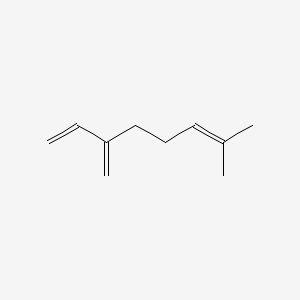| Authors | Title | Published | Journal | PubMed Link |
|---|---|---|---|---|
| Booth JK et al. | Terpene synthases from Cannabis sativa. | 2017 | PLoS ONE | pmid:28355238 |
| Soares-Castro P et al. | Functional Characterization of a 28-Kilobase Catabolic Island from Pseudomonas sp. Strain M1 Involved in Biotransformation of β-Myrcene and Related Plant-Derived Volatiles. | 2017 | Appl. Environ. Microbiol. | pmid:28213543 |
| Burcu GB et al. | The protective cardiac effects of Β-myrcene after global cerebral ıschemia/reperfusion in C57BL/J6 mouse. | 2016 | Acta Cir Bras | pmid:27487280 |
| Oh SY | An Effective Quality Control of Pharmacologically Active Volatiles of Houttuynia cordata Thunb by Fast Gas Chromatography-Surface Acoustic Wave Sensor. | 2015 | Molecules | pmid:26046325 |
| Dai do N et al. | Analysis of essential oil constituents of three Dasymaschalon species (Annonaceae) from Vietnam. | 2014 | Nat. Prod. Res. | pmid:24236527 |
| Bonamin F et al. | The effect of a minor constituent of essential oil from Citrus aurantium: the role of β-myrcene in preventing peptic ulcer disease. | 2014 | Chem. Biol. Interact. | pmid:24480520 |
| Trung HD et al. | Terpene constituents of the leaves of five Vietnamese species of Clausena (Rutaceae). | 2014 | Nat. Prod. Res. | pmid:24617735 |
| Soares-Castro P and Santos PM | Deciphering the genome repertoire of Pseudomonas sp. M1 toward β-myrcene biotransformation. | 2014 | Genome Biol Evol | pmid:25503374 |
| Byers KJ et al. | Floral volatile alleles can contribute to pollinator-mediated reproductive isolation in monkeyflowers (Mimulus). | 2014 | Plant J. | pmid:25319242 |
| Thang TD et al. | A comparative analysis of essential oils of Goniothalamus macrocalyx Ban., Goniothalamus albiflorus Ban. and Goniothalamus tamirensis Pierre ex Fin. & Gagnep. from Vietnam. | 2013 | Nat. Prod. Res. | pmid:23822670 |
Myrcene
Myrcene is a lipid of Prenol Lipids (PR) class. Myrcene is associated with abnormalities such as Hypomenorrhea, abnormal fragmented structure, Nephrosis, Renal tubular disorder and Kidney Diseases. The involved functions are known as Anabolism, Gene Expression, Protein Biosynthesis, Mutation and Selection, Genetic. Myrcene often locates in Plastids, Proboscis, Body tissue, Clone and soluble. The associated genes with Myrcene are TTPA gene, monoterpene synthase, Genome, 4S-limonene synthase and Homologous Gene. The related lipids are Pinene, Octanols, Membrane Lipids and Fatty Acids, Unsaturated.
Cross Reference
Introduction
To understand associated biological information of Myrcene, we collected biological information of abnormalities, associated pathways, cellular/molecular locations, biological functions, related genes/proteins, lipids and common seen animal/experimental models with organized paragraphs from literatures.
What diseases are associated with Myrcene?
Myrcene is suspected in Nephrosis, Kidney Diseases, Dehydration, Hypomenorrhea, Renal tubular disorder and other diseases in descending order of the highest number of associated sentences.
Related references are mostly published in these journals:
| Disease | Cross reference | Weighted score | Related literature |
|---|
No disease MeSH terms mapped to the current reference collection.
PubChem Associated disorders and diseases
What pathways are associated with Myrcene
There are no associated biomedical information in the current reference collection.
PubChem Biomolecular Interactions and Pathways
Link to PubChem Biomolecular Interactions and PathwaysWhat cellular locations are associated with Myrcene?
Visualization in cellular structure
Associated locations are in red color. Not associated locations are in black.
Related references are published most in these journals:
| Location | Cross reference | Weighted score | Related literatures |
|---|
What functions are associated with Myrcene?
Related references are published most in these journals:
| Function | Cross reference | Weighted score | Related literatures |
|---|
What lipids are associated with Myrcene?
Related references are published most in these journals:
| Lipid concept | Cross reference | Weighted score | Related literatures |
|---|
What genes are associated with Myrcene?
Related references are published most in these journals:
| Gene | Cross reference | Weighted score | Related literatures |
|---|
What common seen animal models are associated with Myrcene?
There are no associated biomedical information in the current reference collection.
